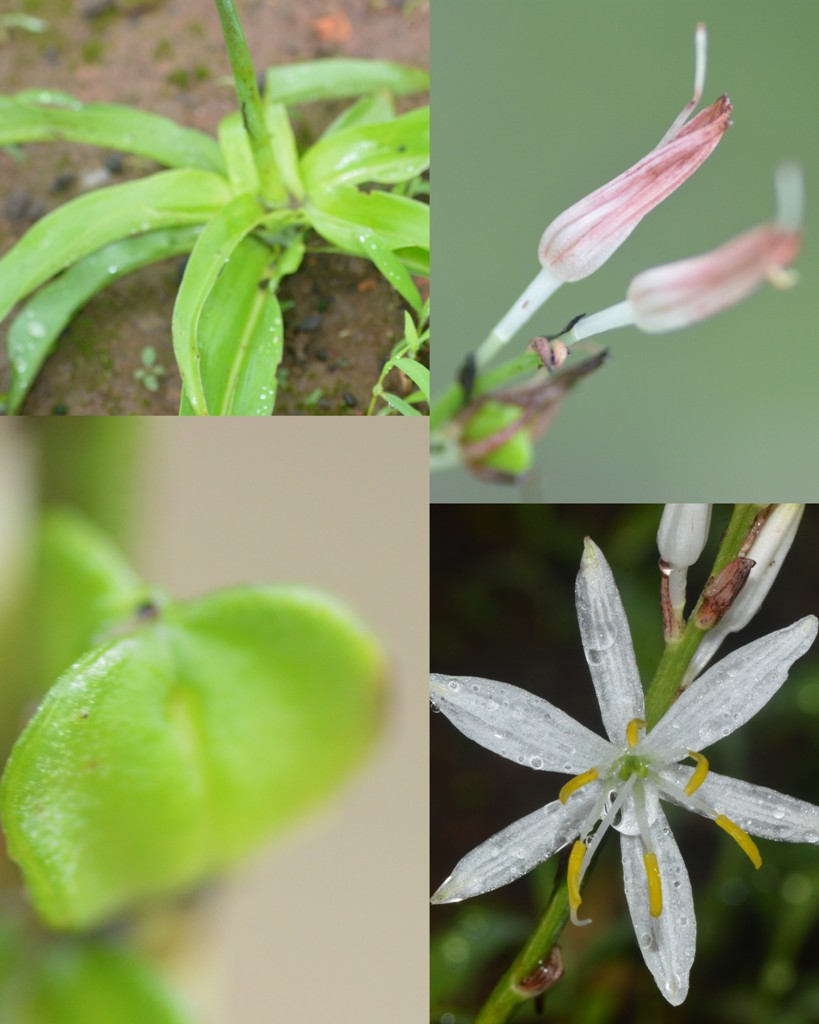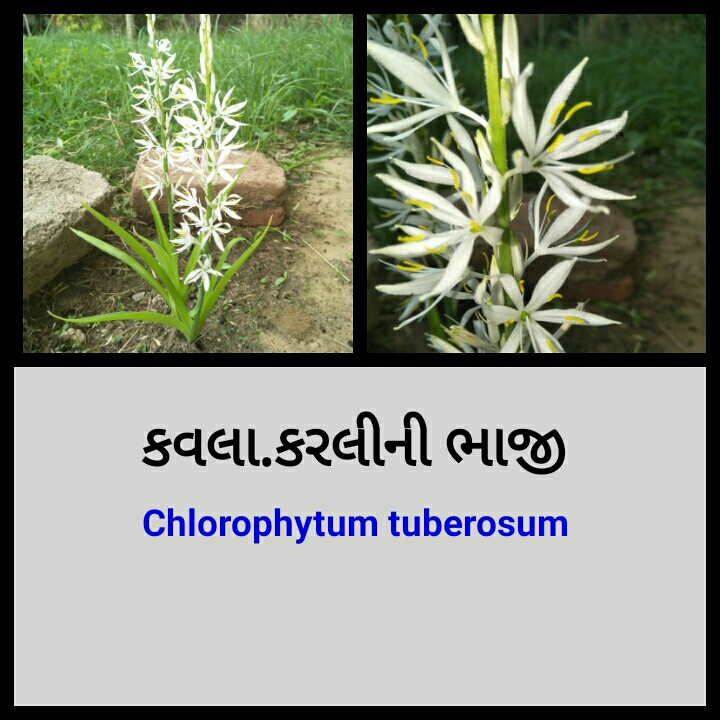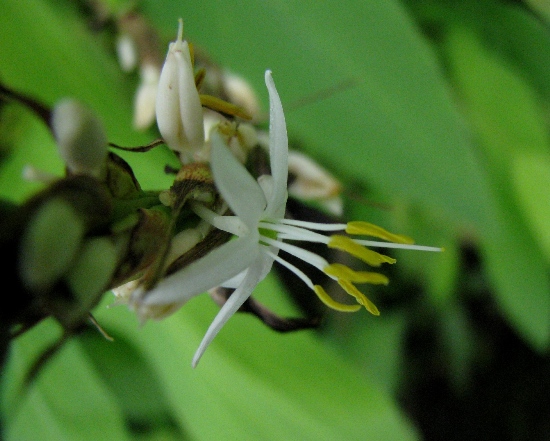|
IUCN Red List Status: Critically Endangered (CR)
. Chlorophytum borivilianum Santapau & R.R.Fern., J. Bombay Nat. Hist. Soc. 3: 898 1955. ; .
kloh-roh-FY-tum — from the Greek chloros (green), and phyton (plant)
bory-wili-YAH-num — of or from Borivili National Park, India . commonly known as: Borivili chlorophytum, safed musali • Gujarati: ધોળુ મૂસળી dholu musli • Hindi: सफ़ेद मुसली safed musli • Marathi: कुळई kulai, सफेत मुसळी safet musli . Endemic to: India (Maharashtra and Gujarat; elsewhere cultivated) . The only way to distinguish between the two is by digging up the plants. In C. borivilianum the tuber touches the stem whereas in C. tuberosum they are attached to the root fibres
. Chlorophytum borivilianum is a herb with lanceolate leaves, from tropical wet forests in peninsular India. The Hindi name is safed musli. It is cultivated and eaten as a leaf vegetable in some parts of India, and its roots are used medicinally as a sex tonic under the name safed musli. The medicinal value is thought to derive from its saponin content, up to 17 percent by dry weight. It has also recently been suggested that it may produce an aphrodisiac agent. As medicinal demand has increased, the plant has been brought under cultivation. The saponins and alkaloids present in the plant are the source of its alleged aphrodisiac properties.
This herb is used in laddoos for women postpartum.
(From Wikipedia on 5.7.13)
.
Chlorophytum tuberosum – second wild flower of the season : Attachments (4). 19 posts by 7 authors.
I saw second wild flower of the season in the forest at CEC, Goregaon, Mumbai today (9.6.10).
Bot. name : Chlorophytum tuberosum local name : Kuli Hindi: Safed Musli famiily Liliaceae One can see these flowers immediately after the first few showers. The leaves are cooked and eaten. This herb is also called edible chlorophytum. Leaves are radical and membranous. Etymology: Chloros = green and Phyton is a plant. Roots are tuberous, hence tuberosum
This is a new plant for me. I am only familiar with C. comosum, the common “spider plant” from South Africa. As far as i know Chlorophytum borivilianum is known as Safed musli !! If I am wrong kindly correct me
As far as i know, both carry same local name in Hindi i.e. सफेद मुसली Nice photographs, but they are of Chlorophytum borivalianum. When u say something, I have to recheck 100 times. C.borivilianum & C.tuberosum are indistinguishable morphologically in the field and also from photographs. At the C.E.C. Chlorophytum borivilianum tend to be in the majority. The only way to distinguish between the two is by digging up the plants. In C. borivilianum the tuber touches the stem whereas in C. tuberosum they are attached to the root fibres.
Have dug up quite a few. Would suggest you do likewise. Sending you my photographs taken at C.E.C. in June 2008. Useful link for identification of different species of Chlorophytum. Botanical What do we do after digging up? Replant them? thanx very much for the explanation. Haven’t been to C.E.C for sometime. Suggest you try along the main driveway. Your question has me foxed. Will pass it on to Dr. Almeida and let you know what his reply is. A picture of Chlorophytum plant dug up from ground. (Vetal tekdi Pune) this is C tuberosum undoubtedly !! … if you are planning to use it as medicine then I must say that it is still immature. After fall of all leaves, tuber is considered mature and used as medicine. Here is Google link for my work on Chlorophytum. Link for identification of different Chlorophytum species. I do not intend to use it at all. That was only for study purpose. I have replanted it in the same area. Please apply leaf leachate of Curculigo orchioides near base of replanted Safed Musli. It will help to recover from injury. Chlorophytum for ID | Matheran | July,13` : Attachments (1). 4 posts by 2 authors. looks Chlorophytum borivilianum
Requesting to please ID this Chlorophytum species captured in Shilondha, SGNP, Mumbai in June 2014.
Is this C. tuberosum? According to Dr. Almeida most of the species found in the BNP are C.borivalianum. However, please check this link : Google Groups Thank you … for the ID and the information… I will assume this to be Chlorophytum borivalianum. Next time I come across it, I will try to l look for the tubers. However, I feel it is criminal to dig out such beautiful looking flowers 🙁
For id Kr 030718 : 3 posts by 1 author. Attachments (1)
For id pl.
Do not match with images at Chlorophytum tuberosum (Roxb.) Baker
Closest I can go as per comparative images at Chlorophytum is Chlorophytum borivilianum Santapau & R.R.Fern.
Flowers indicates Chlorophytum borivilianum
Chlorophytum tuberosum करली भाजी सफेद मूसली
But it was identified as Chlorophytum borivilianum
.
Chlorophytum tuberosum : 7 posts by 4 authors. Attachments (1)
Chlorophytum tuberosum ?
Do not match with images at Chlorophytum tuberosum (Roxb.) Baker
Closest I can go as per comparative images at Chlorophytum is Chlorophytum borivilianum Santapau & R.R.Fern.
where is this picture composite from? from a book? from a website? your own? This picture taken from gujarat barda Hil oh ok. nice to know. my question was: is the picture you just showed us, is it from a book? or is it your own making Agreeing with …, not C. tuberosum, most likely to be C. borivilianum.
Chlorophytum tuberosum – second wild flower of the season – efloraofindia | Google Groups Chlorophytum Species for ID : Nasik : 30JUN19 : AK-3 : 7 posts by 2 authors. Attachments (4)
Chlorophytum Species seen on a mountain slope on the 25th of June. Very tiny plants. For Species id please.
Pl. check comparative images at Thanks … To me it looks close to Chlorophytum borivilianum, Safed Musli as in FOI. Why are you posting such small images these days ?
To me also appears close to images at Chlorophytum borivilianum Santapau & R.R.Fern. as per comparative images at Chlorophytum The setting might have changed. Not done purposely. Will post higher resolution images. Thanks for bringing to my notice.
Posting better resolution images. Hope these help.
Attachments (3)
|
Chlorophytum borivilianum
Updated on December 24, 2024






